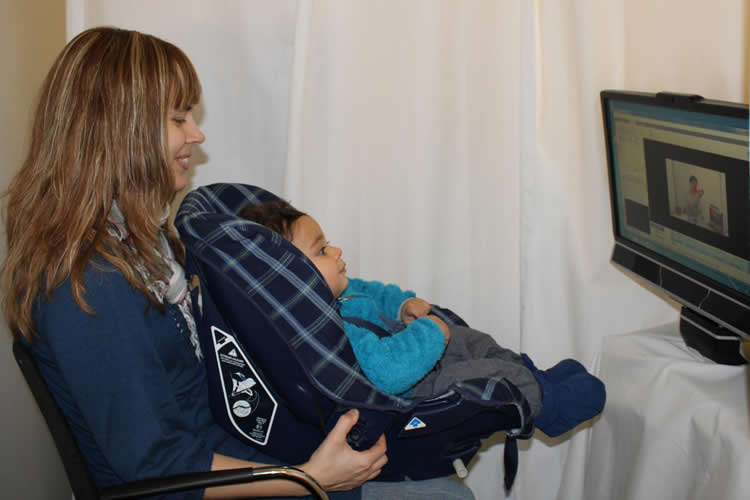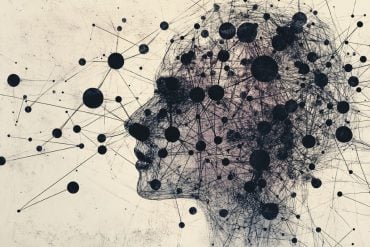Summary: Infants who pay little attention to synchronous sights and sounds could have an elevated risk of being diagnosed with autism, researchers report.
Source: Uppsala University.
An ability to integrate information from different sensory modalities is important for infants’ development and for their perception of the environment. A new study suggests that infants who pay little attention to synchronous sights and sounds may be at elevated risk for developing autism spectrum disorder (ASD). This knowledge about early development in ASD may contribute to earlier detection and intervention in the future.
The findings were recently published in the Journal of Child Psychology and Psychiatry. The researchers let the infants observe a computer screen on which half of the screen showed objects that moved in synchrony with a sound and the other half showed objects that moved without any relation to the sound. The participants who fulfilled criteria for ASD at three years of age looked equally long at both sides, while children with typical development showed a strong preference for audiovisual synchrony, defined as changes in object velocity happening at the same time as changes in sound volume.
“We expected an effect in this direction, but were nevertheless surprised to see that the group differences were so large,” says Terje Falck-Ytter, Associate Professor at the Department of Psychology, Uppsala University, and Principal Investigator for the study. “We believe the findings are important because they point to a rather basic function that has not been studied much earlier in this context.”
The study is a part of the larger project Early Autism Sweden (EASE), which is a collaboration between Uppsala University and the Center of Neurodevelopmental Disorders at Karolinska Institutet (KIND). The project includes younger siblings of children with ASD, ADHD or language disorder. The infants are followed longitudinally from five months of age until they reach six years. The participants in the current experiment were 10 months old when their visual preferences were examined and were followed until three years, when the diagnostic evaluation was conducted. In total, 33 infants with an older sibling with ASD took part in the study, of whom thirteen met criteria for ASD at follow-up. The study also included a control group consisting of fourteen infants at low (average) risk for ASD.

“Currently, ASD cannot be reliably diagnosed before 2-3 years of age, and despite a lot of research we still know too little about the causes. Even if twin studies suggest that genetic factors play an important role, we still do not know enough about which specific genes are involved and how they affect the developing brain to cause ASD. Our philosophy is that studying the early development of ASD will help clarify the picture,” Falck-Ytter explains.
The results demonstrated significant group differences, but it is too early to say whether the method in its current form can facilitate early detection in a clinical context.
“We used eye tracking to measure the infants’ gaze, and the experiment lasted only a few minutes. It is of course fascinating and promising that one can forecast with some degree of accuracy how a child will develop based on such a short measurement of gaze patterns. At the same time it is important to bear in mind that significant results at the group level do not imply that one can take this eye tracking ‘test’ and get accurate results on an individual level,” says Falck-Ytter.
Source: Terje Falck-Ytter – Uppsala University
Publisher: Organized by NeuroscienceNews.com.
Image Source: NeuroscienceNews.com image is credited to Terje Falck Ytter.
Original Research: Abstract in Journal of Child Psychology and Psychiatry.
doi:10.1111/jcpp.12863
[cbtabs][cbtab title=”MLA”]Uppsala University “Reduced Attention to Audiovisual Synchrony in Infancy Predicts Autism Diagnosis.” NeuroscienceNews. NeuroscienceNews, 23 January 2018.
<https://neurosciencenews.com/autism-audiovisual-synchrony-8345/>.[/cbtab][cbtab title=”APA”]Uppsala University (2018, January 23). Reduced Attention to Audiovisual Synchrony in Infancy Predicts Autism Diagnosis. NeuroscienceNews. Retrieved January 23, 2018 from https://neurosciencenews.com/autism-audiovisual-synchrony-8345/[/cbtab][cbtab title=”Chicago”]Uppsala University “Reduced Attention to Audiovisual Synchrony in Infancy Predicts Autism Diagnosis.” https://neurosciencenews.com/autism-audiovisual-synchrony-8345/ (accessed January 23, 2018).[/cbtab][/cbtabs]
Abstract
Reduced orienting to audiovisual synchrony in infancy predicts autism diagnosis at 3 years of age
Background
Effective multisensory processing develops in infancy and is thought to be important for the perception of unified and multimodal objects and events. Previous research suggests impaired multisensory processing in autism, but its role in the early development of the disorder is yet uncertain. Here, using a prospective longitudinal design, we tested whether reduced visual attention to audiovisual synchrony is an infant marker of later-emerging autism diagnosis.
Methods
We studied 10-month-old siblings of children with autism using an eye tracking task previously used in studies of preschoolers. The task assessed the effect of manipulations of audiovisual synchrony on viewing patterns while the infants were observing point light displays of biological motion. We analyzed the gaze data recorded in infancy according to diagnostic status at 3 years of age (DSM-5).
Results
Ten-month-old infants who later received an autism diagnosis did not orient to audiovisual synchrony expressed within biological motion. In contrast, both infants at low-risk and high-risk siblings without autism at follow-up had a strong preference for this type of information. No group differences were observed in terms of orienting to upright biological motion.
Conclusions
This study suggests that reduced orienting to audiovisual synchrony within biological motion is an early sign of autism. The findings support the view that poor multisensory processing could be an important antecedent marker of this neurodevelopmental condition.







